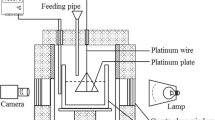Abstract
The relationships of dissolution rate to alumina specifications and bath chemistry including electrolyte composition, operating temperature and superheat were investigated. The key physiochemical properties of industrial alumina samples were tested including moisture content, loss on ignition, surface area and phase composition. The dissolution of these samples in several bath compositions was observed through a quartz crucible equipped with a visual recording system. The dissolution rate increased with increasing loss on ignition and surface area. The operating temperatures and existing alumina concentration in the electrolyte had a greater impact on the alumina dissolution rate than the minor change of the bath compositions and superheat. Same trends were also obtained for the lab-calcined alumina samples.












Similar content being viewed by others
References
L. Levin and D. Brandon, J. Am. Ceram. Soc. 81, 1995–2012 (1998).
B. Whittington and D. Ilievski, Chem. Eng. J. 98, 89–97 (2004).
M. Hyland, A. Gillespie, and J. Metson, Light Metals (Warrendale, PA: TMS, 1997), pp. 113–117.
W.E. Haupin and H. Kvande, Essent. Read. Light Met. Alum. Reduct. Technol. 2, 903–909 (1993).
W.E. Haupin, Light Metals (Warrendale, PA: TMS, 1984), pp. 1429–1439.
M.M. Hyland, E.C. Patterson, and B.J. Welch, Light Metals (Warrendale, PA: TMS, 2004), pp. 361–366.
N. Wai-Poi and B.J. Welch, Light Metals (Warrendale, PA: TMS, 1994), pp. 345–350.
A.B. Heiberg, G. Wedde, O.K. Bockman, and S.O. Strommen, Light Metals (Warrendale, PA: TMS, 1999), pp. 255–261.
D.S. Wong, N.I. Tjahyono, and M.M. Hyland, Light Metals (Orlando, FL: TMS, 2012), pp. 833–838.
Å. Sterten, Electrochim. Acta 25, 1673–1677 (1980).
B. Gilbert, E. Robert, E. Tixhon, J.E. Olsen, and T. Østvold, Light Metals (Warrendale, PA: TMS, 1995), pp. 181–194.
E. Robert, J.E. Olsen, V. Danek, E. Tixhon, T. Østvold, and B. Gilbert, J. Phys. Chem. B. 101, 9447–9457 (1997).
Y. Zhang and R.A. Rapp, Metall. Mater. Trans. B 35B, 509–515 (2004).
G. I. Kuschel, The Effect of Alumina Properties and Smelter Operating Conditions on the Dissolution Behaviour of Alumina, PhD thesis, The University of Auckland, Auckland, New Zealand, 1990
B.J. Welch and G.I. Kuschel, JOM 59, 50–54 (2007).
E. Skybakmoen, A. Solheim, and Å. Sterten, Metall. Mater. Trans. B 28, 81–86 (1997).
R.G. Haverkamp and B.J. Welch, Chem. Eng. Process. 37, 177–187 (1998).
J. Tie, Z. Qiu, and G. Lu, Non-ferrous Met. 46, 49–51 (1994).
L.B. McCusker, R.B. Von Dreele, D.E. Cox, D. Louer, and P. Scardi, J. Appl. Cryst. 32, 36–50 (1999).
Y. Yang, B. Gao, Z. Wang, Z. Shi, and X. Hu, Metall. Mater. Trans. B 44, 1296–1303 (2013).
Y. Yang, B. Gao, Z. Wang, Z. Shi, X. Hu, and J. Yu, Metall. Mater. Trans. B 45, 1150–1156 (2014).
X. Hu, J. Qu, B. Gao, Z. Shi, F. Liu, and Z. Wang, T. Nonferr. Metal. Soc. 21, 402–406 (2011).
A.R. Johnson, Light Metals (Warrendale, PA: TMS, 1981), pp. 373–387.
P. Chartrand and A.D. Pelton, Light Metals (Warrendale, PA: TMS, 2002), pp. 245–252.
L. Less, Light Metals, Vol. 1 (New York, NY: TMS, 1976), pp. 315–331.
J. Thonstad, F. Nordmo, and J.B. Paulsen, Metall. Trans. 3, 403–408 (1972).
Acknowledgements
The authors would like to express their gratitude for the financial support provided by the National Key Technology Research and Development Program of the Ministry of Science and Technology of China (Grant No. 2012BAE08B01), the National Natural Science Foundation of China (Grant Nos. 51074045, 51074046, 51228401, 51322406, 51434005, 51474060), the NEU foundation (No. N130402011).
Author information
Authors and Affiliations
Corresponding author
Rights and permissions
About this article
Cite this article
Yang, Y., Gao, B., Wang, Z. et al. Effect of Physiochemical Properties and Bath Chemistry on Alumina Dissolution Rate in Cryolite Electrolyte. JOM 67, 973–983 (2015). https://doi.org/10.1007/s11837-015-1379-7
Received:
Accepted:
Published:
Issue Date:
DOI: https://doi.org/10.1007/s11837-015-1379-7




